- News
- Reviews
- Bikes
- Components
- Bar tape & grips
- Bottom brackets
- Brake & gear cables
- Brake & STI levers
- Brake pads & spares
- Brakes
- Cassettes & freewheels
- Chains
- Chainsets & chainrings
- Derailleurs - front
- Derailleurs - rear
- Forks
- Gear levers & shifters
- Groupsets
- Handlebars & extensions
- Headsets
- Hubs
- Inner tubes
- Pedals
- Quick releases & skewers
- Saddles
- Seatposts
- Stems
- Wheels
- Tyres
- Tubeless valves
- Accessories
- Accessories - misc
- Computer mounts
- Bags
- Bar ends
- Bike bags & cases
- Bottle cages
- Bottles
- Cameras
- Car racks
- Child seats
- Computers
- Glasses
- GPS units
- Helmets
- Lights - front
- Lights - rear
- Lights - sets
- Locks
- Mirrors
- Mudguards
- Racks
- Pumps & CO2 inflators
- Puncture kits
- Reflectives
- Smart watches
- Stands and racks
- Trailers
- Clothing
- Health, fitness and nutrition
- Tools and workshop
- Miscellaneous
- Buyers Guides
- Features
- Forum
- Recommends
- Podcast
review
£2,999.99
VERDICT:
Fast, stiff & packing the latest Ultegra Di2 11-speed; slightly let down by lack of smoothness, but racers will love it
Weight:
8,100g
Contact:
www.orbea.com
At road.cc every product is thoroughly tested for as long as it takes to get a proper insight into how well it works. Our reviewers are experienced cyclists that we trust to be objective. While we strive to ensure that opinions expressed are backed up by facts, reviews are by their nature an informed opinion, not a definitive verdict. We don't intentionally try to break anything (except locks) but we do try to look for weak points in any design. The overall score is not just an average of the other scores: it reflects both a product's function and value – with value determined by how a product compares with items of similar spec, quality, and price.
What the road.cc scores meanGood scores are more common than bad, because fortunately good products are more common than bad.
- Exceptional
- Excellent
- Very Good
- Good
- Quite good
- Average
- Not so good
- Poor
- Bad
- Appalling
Orbea's Orca B M10 is a very capable road bike, despite being far from having the snappiest name. It offers a resounding turn of speed and crisp handling that will cater for the demands of any cyclist planning a summer of sportives or road races this year. Add in the latest Shimano Ultegra Di2 11-speed groupset, a direct descendent from Dura-Ace, and there's a lot going for the Orca.
Ride: Quick and fast handling, but not very smooth
The Orca is impressively quick when applying power through the pedals. It handles corners and bends with grace, and a well balanced handling that sharpens the harder you push the bike.
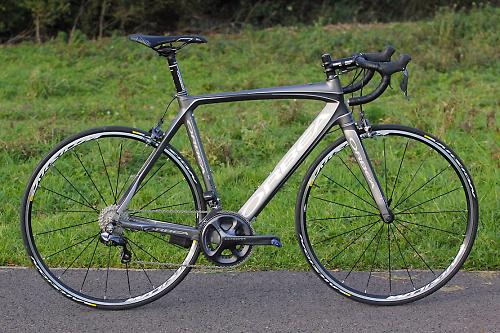
The geometry is a little shorter than the racier Orca models higher up the range. The most significant change is the shorter front end, so the bars are less of a stretch; I found the Ultegra hoods fitted perfectly in my hands. The racey DNA is exhibited in the short 16.5cm head tube and short wheelbase, which combine to produce fast handling and a bike that positively wants to be slung along a challenging road full of dips, rises, sweeping bends and tight hairpins.

There is plenty of stiffness to exploit. Racers will revel in its power transfer and the immediate way it responds to pedalling inputs. It feels laterally very taut, a trait most displayed on fast descents. Its stiffness is apparent when hustling the bike along the road. Show it a hill, and that 8.1kg weight doesn't serve to blunt the bike's speed as much as I feared it might at the beginning of the test. It rides faster than the weight might suggest. Just goes to show that you should never judge a bike until you've ridden it.
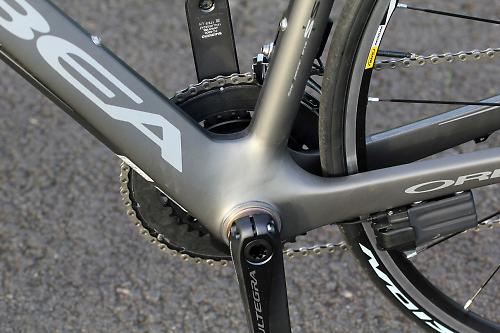
For all its composure and inspired handling, the Orca comes unstuck in its dealings with rough road surfaces. Despite Orbea's clear intention to tame some of the vibration in the shaping of the frame, it doesn't handle imperfections in the surface very well. The result is, at times, quite a harsh ride. It can be a bit tiring towards the end of a long stint in the saddle. Which is a shame because everything else about the bike is lovely. I just wish it was a little smoother.
Get it on a crit circuit and I'm absolutely confident it would be a flawless performer. The handling, stiffness and way it delivers speed would see it being well suited to the fast and frantic world of crit racing. Away from the track and on regular roads, while it's not a bad choice, there are smoother rides.

Frame: Distinctive carbon features
It's a distinctive looking frame, is the Orca. This is a bike you could recognise simply from its silhouette. It's a very similar frame to the new top-end Orca introduced at the Tour de France last year, and raced by the now defunct Euskaltel-Euskadi team. But there are some differences.
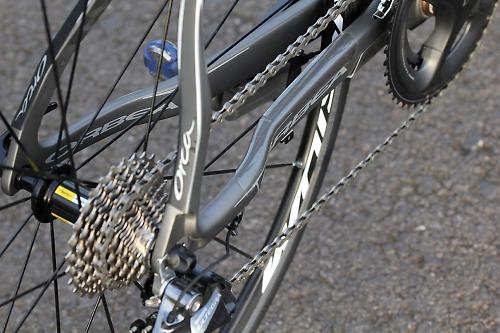
The most significant is the grade of carbon used, and it's this factor that probably reveals itself in the ride character. Orbea don't go into much details about the specifics of the carbon, instead they have their own labelling system, splitting the range up into those using 'performance' carbon and, like the Orca here, 'evolution' carbon.
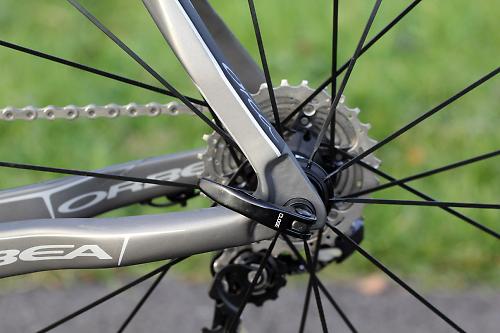
The frame doesn't have the same level of integration as the top-end Orca, but it does have main tubes that have been shaped in a wind tunnel. It seems no bike can escape the clutches of an aerodynamicist these days. Orbea have what they call AIZoneE (aerodynamics investigation zone) and it is the shaping of the main tubes and the head tube. The head tube is noticeably pinched in at the middle to produce a smaller frontal area to meet the air. The down tube is clearly an aero shape, with a round leading edge and tapered trailing edge. The trailing edge is flattened at the bottle cage mount.
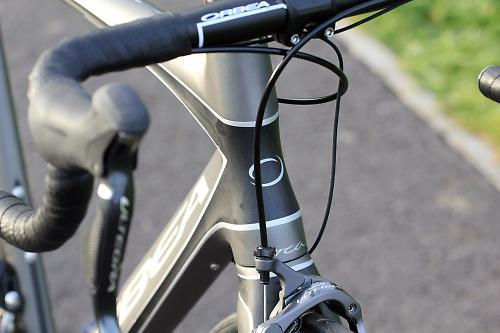
That aero down tube is massive, and blends into a huge bottom bracket junction. There's a press fit bottom bracket, naturally. A pair of chunky chainstays branch off it and the and the seat tube is slightly ovalised with a hint of a cutaway close to the rear wheel. The top half of the frame is split 50:50 between the oversized front end of the head tube, and the thin seat stays.
The frame is Di2 compatible, but the redundant cable stops are an ugly reminder of the frame's age. However, the battery is smartly located on the non-driveside chainstay, a better location than the down tube or bottom bracket in my opinion.
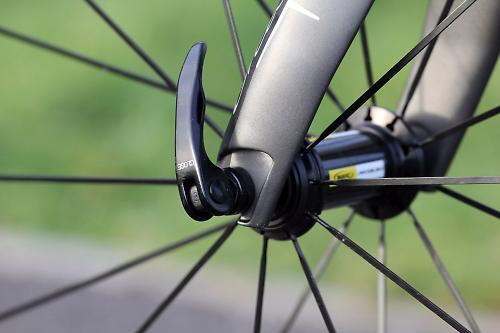
I'm not a huge fan of internal cable routing, and the Orca didn't do much to win me over. The rear brake cable is routed through the top tube, entering and exiting on the same side. This causes the cable to rattle against the inside of the tube. It's noisy, and exaggerated by the rigidity of the frame. It really takes the shine of the bike when it's constantly making a noise. I'm not sure what the solution is, other than arranging the routing so the cable passes diagonally through the top tube.
Build: Faultless Shimano Ultegra Di2 electronic shifting
This Orca frame is available from just £1,349 with Shimano Sora, and tops out with this £2,999 model. Above this price the range switches to the more expensive Orca carbon frame and goes all the way to £8,699.
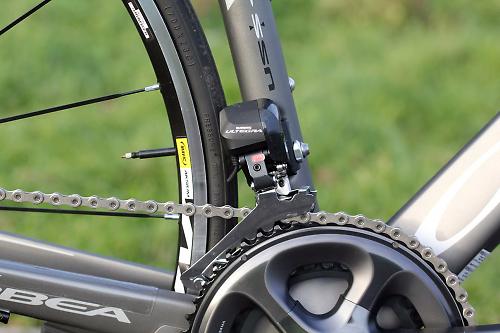
Yes, £3,000 is a lot of money, but there are few manufacturers offering the new Ultegra Di2 6870 11-speed groupset on a carbon frame at this price, given the higher price of the electronic groupset over its mechanical counterpart. A quick look around revealed a similarly specced bike from most manufacturers would set you back another £200-500 at least.
The new groupset is hugely impressive. I'm a big fan. The hood shape has been tweaked a bit. I find my fingers wrap around the lower section of the hood much more easily than the mechanical version, that makes them for more far more comfortable than mechanical.

Shifting, well it's instant, sharp and quiet, as anyone who regularly uses Di2 will be well used to. The groupset is much nicer looking than its predecessor as well, the rear mech in particular. They've reduced the bulk of the motor and given it a smart, shiny finish. Unlike Dura-Ace, the brake levers are aluminium rather than carbon, to save a bit of money. The junction box sits below the stem, attached with a narrow rubber band. It's a bit more fiddly to fit a computer over the top of the stem, but not impossible.

Wheels are Mavic's entry-level Askiums, shod with the French company's own 23mm tyres. These wheels are a popular choice on lots of bikes at the more affordable end of the spectrum, and it's clear getting the Di2 groupset onto a bike costing under £3,000 has impacted the wheel choice. That said, there are few bikes with Ultegra Di2 at this price that you can walk into a shop and purchase. The Orbea website lets you upgrade to Mavic's Ksyrium Equipe WTS wheels for an extra £157.50, which might be a good choice if you want to invest in the future with slightly lighter wheels.
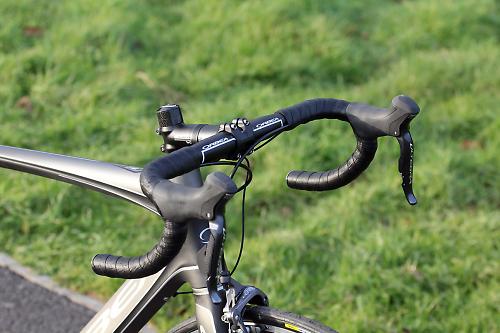
There's nothing radical or fancy about the Orbea branded finishing components. The alloy stem, compact handlebars and carbon seatpost might lack the pizazz of more expensive parts, but they work reliably. The handlebar proved a nice shape, the bend giving a generous reach and drop. The Selle Italia SL Flow looks the part, but wasn't my cup of tea comfort wise.

Verdict
A fast and stiff frame packing the latest Ultegra Di2 11-speed group, but slightly let down by its lack of smoothness. Racers will love it.
road.cc test report
Make and model: Orbea Orca B M10
Size tested: 56cm
About the bike
State the frame and fork material and method of construction. List the components used to build up the bike.
The Orca Bronze M10 is our top-notch Orca Bronze bicycle. Part of its magic is Shimano's Ultegra Di2 shifting components. However, the Bronze level carbon fiber frame shares more than good looks with the Orca OMR and OMP road bikes; the ride is superb and tames coarse roads for more comfort. And as we've said before, the feel and function of the Ultegra Di2 components are so closely matched to their Dura-Ace counterparts that they give away nothing in terms of performance. We finish the Orca Bronze M10 with a smart blend of components that balance affordability, performance, and durability.
Tell us what the bike is for, and who it's aimed at. What do the manufacturers say about it? How does that compare to your own feelings about the bike?
AIZONE - Orbea created AIZONE because we recognize that aerodynamics and rigidity are the most important parameters to consider when developing fast bicycles. Both must be optimized to create a bicycle frame that is not only fast, but that can also efficiently transmit your power to the rear wheel.
ATTRACTION - Attraction insulates you from the realities of the road surface. This allows you to ride at peak performance, have more control, and benefit from more traction at all times. When you hit bumps, the compressive forces are converted into shear movement in the shaped bends on the seatstays.
MONOCOQUE - Monocoque guarantees a carbon structure with optimum performance and long term reliability, and it's the only way Orca ever done it. We mold the one-piece structures so that each tube is connected to the next, with continuous fibers through each critical juncture. As you ride, your bike will be subjected to a variety of forces – tension, compression, torsion, etc. Orca's monocoque frames allow optimal distribution of these forces over the entire structure because of the perfect fusion of the composite materials.
Frame and fork
Overall rating for frame and fork
8/10
Tell us about the build quality and finish of the frame and fork?
Decent build quality. It's shame to see the rather ugly cable stops for the mechanical groupset still on the frame.
Tell us about the materials used in the frame and fork?
It's their own Evolution carbon fibre.
Tell us about the geometry of the frame and fork?
Geometry is a little shorter in the top tube, but the head tube keeps it quite racey at 16.5cm, favouring riders who like an aggressive head down position.
How was the bike in terms of height and reach? How did it compare to other bikes of the same stated size?
A short head tube, just how I like it, but Orbea provided a few spacers so there is scope to raise and lower the bar height as you wish.
Riding the bike
Was the bike comfortable to ride? Tell us how you felt about the ride quality.
It lacked the comfort of a lot of other carbon frames at this price, and on anything but a silky smooth road the ride was choppy and crashy.
Did the bike feel stiff in the right places? Did any part of the bike feel too stiff or too flexible?
Oh yes, stand on the pedals and it powers forward. There was a good level of stiffness detectable through the front end as well.
How did the bike transfer power? Did it feel efficient?
Yes.
Was there any toe-clip overlap with the front wheel? If so, was it a problem?
No.
How would you describe the steering? Was it lively, neutral or unresponsive? Lively.
Tell us some more about the handling. How did the bike feel overall? Did it do particular things well or badly?
For fast and aggressive riding the Orca is a fine companion. It does leisurely rides okay, provided you're used to a fairly aggressive geometry.
Which components had the most effect (good or bad) on the bike's comfort? would you recommend any changes?
Some carbon handlebars, and a possible change of wheels and tyres, might go some way to removing the harshness the bike exhibited on rough roads.
Which components had the most effect (good or bad) on the bike's stiffness? would you recommend any changes?
There was certainly no lack of stiffness from any of the components, for racing this bike would be a fine choice.
Which components had the most effect (good or bad) on the bike's efficiency? would you recommend any changes?
I'm not a fan of the Mavic tyre, they don't feel especially quick or that adhesive to the road in bad conditions, so I'd probably upgrade them when they wear out.
Rate the bike for efficiency of power transfer:
9/10
Rate the bike for acceleration:
8/10
Rate the bike for sprinting:
9/10
Plenty of gusto when sprinting.
Rate the bike for high speed stability:
8/10
Yes pretty good, especially on the downs.
Rate the bike for cruising speed stability:
8/10
Rate the bike for low speed stability:
8/10
Rate the bike for flat cornering:
8/10
Rate the bike for cornering on descents:
8/10
Rate the bike for climbing:
7/10
The bike hides its weight well, but on prolonged and very steep climbs it's hard not to ignore the fact the Orca is carrying just a bit too much weight for a £3K bike.
The drivetrain
Rate the drivetrain for performance:
9/10
With the updated Ultegra Di2, Dura-Ace Di2 needs to up its game.
Rate the drivetrain for durability:
8/10
Can't foresee any problems. Just remember to charge the Di2 battery... ahem.
Rate the drivetrain for weight:
8/10
Rate the drivetrain for value:
8/10
Tell us some more about the drivetrain. Anything you particularly did or didn't like? Any components which didn't work well together?
Superb shifting and very good brakes.
Wheels and tyres
Rate the wheels and tyres for performance:
8/10
Nothing really wrong with the Mavic wheels, they're sturdy and durable, but not the lightest.
Rate the wheels and tyres for durability:
8/10
Plenty of mileage in the tyres and long bearing service intervals.
Rate the wheels and tyres for weight:
7/10
Rate the wheels and tyres for comfort:
7/10
Rate the wheels and tyres for value:
8/10
Controls
Rate the controls for performance:
8/10
Rate the controls for durability:
8/10
Rate the controls for weight:
7/10
Rate the controls for comfort:
8/10
Tell us some more about the controls. Any particularly good or bad components? How would the controls work for larger or smaller riders?
Not a fan of the saddle, but that's easily changed. The Orbea stem and handlebar is nice kit, if not snazziest.
Your summary
Did you enjoy riding the bike? Yes I did.
Would you consider buying the bike? I'd want a ride on the higher end Orca frame, which uses a better grade of carbon fibre, first.
Would you recommend the bike to a friend? A racer friend, yes.
Rate the bike overall for performance:
7/10
Rate the bike overall for value:
8/10
Anything further to say about the bike in conclusion?
I really liked riding the Orbea. While it lacks the smoothness of many other carbon frames, it's a sprightly and engaging ride that will suit anyone speed demons, racers or sportivistas. It's a good choice for racing too, where the pinpoint accuracy of its handling and power transfer will impress. It's a bit on the portly side, but happily the weight didn't really highlight itself as much as the extreme rigidity of the Orca.
About the tester
Age: 31 Height: 180 Weight: 67
I usually ride: My best bike is:
I've been riding for: 10-20 years I ride: Every day I would class myself as: Expert
I regularly do the following types of riding: road racing, time trialling, cyclo cross, commuting, touring, mtb,
David worked on the road.cc tech team from 2012-2020. Previously he was editor of Bikemagic.com and before that staff writer at RCUK. He's a seasoned cyclist of all disciplines, from road to mountain biking, touring to cyclo-cross, he only wishes he had time to ride them all. He's mildly competitive, though he'll never admit it, and is a frequent road racer but is too lazy to do really well. He currently resides in the Cotswolds, and you can now find him over on his own YouTube channel David Arthur - Just Ride Bikes.
Latest Comments
- Rome73 2 sec ago
An angle grinder would cut through that Kryptonite D lock in about 5 seconds. Same with the chain.
- HKR 33 min 46 sec ago
It's not 4k though. It's a 4k sensor. But when image stabilization is on, that's chopped down to little over a 1080 image. ...
- tootsie323 1 hour 51 min ago
Or, possibly, a pretty sharp chip...
- ROOTminus1 5 hours 59 min ago
I struggled to find MTB flat shoes that fit my duck-like feet, and buying regular trainers is a pain enough. When I tried to look at road shoes...
- captain_slog 9 hours 47 min ago
Nice idea. Il Lombardia: la classica delle foglie morte. Because that name, Lake Como in autumn, Coppi and proper climbs.
- Dnnnnnn 9 hours 56 min ago
It might have stretched to that metre, and I suspect it was only available for active travel capital projects - but the general public just see...
- Bungle_52 11 hours 31 min ago
Well now I've heard the excuses and had time to digest them I'm not impressed to say the least....
- Rendel Harris 12 hours 31 min ago
Definitely legal and a number of teams have used them, I remember an interview with IPT's chief technician a couple of years back where he revealed...
- slc 12 hours 42 min ago
I cycled up Marsh Lane yesterday, and went through the bus gate behind the new number 16 bus (temple meads to kingswood via barton hill). So that...




































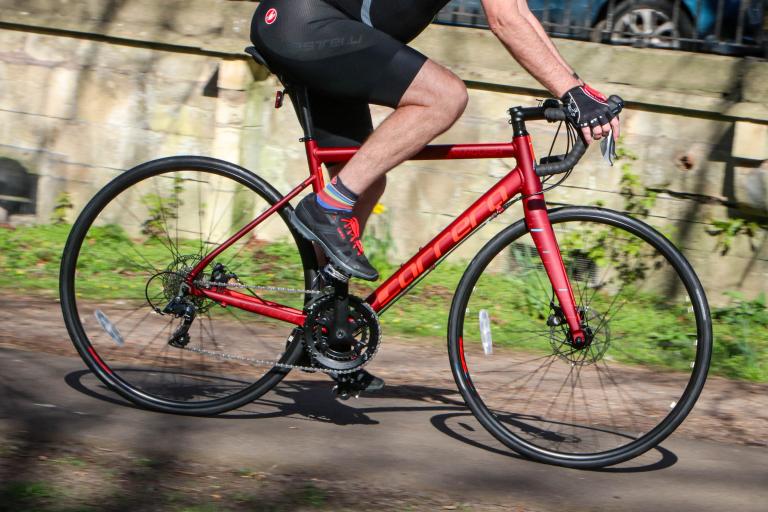



Add new comment
3 comments
I was thinking of the orca (105 version) for my first dip into carbon and sportives this year. Sorry, hide your disgust, I am a mamil. But looking at their Avent I'm not sure now. Pros of the latter... discs, mudguards, geometry, future proofing. But then I already have a disc bike with mudguards, albeit an aluminium cross bike and I haven't found many Avent reviews. Anybody got any pointers or advice?
I've the 2012 model tested and this is a pretty fair review. It's not only a great looking bike that really turns heads, but it is phenomenally quick, the power transfer is impressive and it handles brilliantly on fast, technical descents. Climbs well too.
The Di2 is exceptional - I doubt I'll ever go back to manual.
The internal cabling has never been a gripe for me though and as for comfort, I've dropped the psi down by 10 and have found it really comfortable ride - but you are right about the saddle.
Wheels are fine, OK they are entry level but we all love upgrades, don't we?
I do admire the Orbea bike range both road and mtb's, however they never seem to get rave reviews. I fancy the Advant in the garage due to the discs and mudguards.